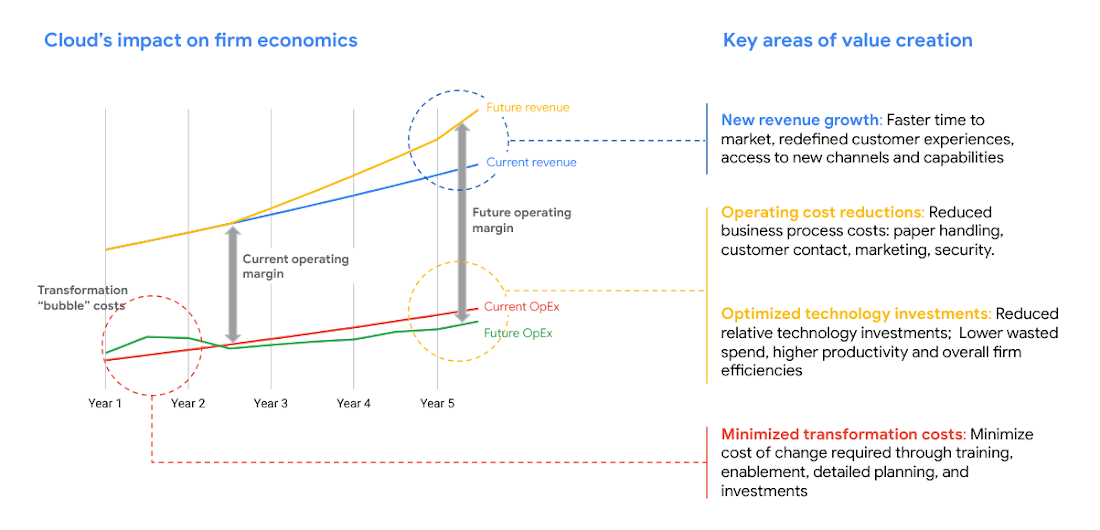Cloud Econ 101: Do your cloud investments pass the ROI test?

James Tsai
Financial Services Lead, Customer Value & Transformation Advisory, Google Cloud
Welcome to Cloud Economics, where you will learn how to measure the efficiency and effectiveness of your cloud investments.
Once upon a time, organizations largely adopted the cloud as a way to save on IT costs. While still an important consideration, more often these days cloud is integral to organizations innovation agenda, whether that’s through real-time consumer preferences, dynamic supply chain management, pinpoint threat intelligence, or the latest AI (both general AI and newer generative AI).
With the pace of change, in cloud, business, and everything else, accelerating so much, some leaders are beginning to wonder if they’re still seeing all the promised value and benefits they envisioned at the outset of their migration. How can they best measure the return on their IT investments? Furthermore, how can they continually optimize these investments to capture and grow this value over time?
It’s a question of cloud economics.
In this new biweekly series, we’ll lay out the ways organizations can use cloud economics to achieve greater visibility into the effectiveness and efficiency of their cloud investments, the return on those investments, and their success in aligning business and technology goals. It’s a new way of measuring and assessing IT spending and performance, aiming to achieve true value.
Welcome to Cloud Econ 101. Because if you don’t test and grade your IT investments, how can you be sure they aren’t failing you?
The sources of value in cloud computing
The underlying value of the cloud comes from giving IT teams and their business counterparts access to capabilities that were previously unavailable, or that were cost prohibitive using on-premises technologies and architectures. This includes the ability to quickly spin computing resources up and down to address fluctuations in global demand; autoscaling compute and analytics platforms to track information as varied as user interests and supply chain interference; and new advances in AI and machine learning, whether that’s the latest natural language processing or IoT integration.
There are a few basic categories into which we can group these advantages:


Optimized IT investments: On-demand, dynamic technology infrastructure found in the cloud enables firms to only pay for what they need, when they need it. This means organizations can stop investing in depreciating assets such as costly data centers, while at the same time provisioning right-sized computing environments in near real-time. This shift can dramatically reduce IT infrastructure spending. The cloud also makes best practices like DevSecOps — where teams from across IT work closely on creating, running, and security applications — more feasible. This leads to programs and services with better capabilities, faster deployment, and higher levels of security.
Reduced operating expenses: While optimizing IT investments helps organizations lower their overall IT spend, an often unconsidered benefit of cloud computing is maximizing the capabilities of each dollar invested. Beyond direct savings impacts, advances in AI/ML based natural language processing are enabling front line workers to automate processes, work faster, and collaborate more effectively. Providing the right digital tools ultimately drives improved employee productivity, and enables flatter FTE and process cost growth over time.
Revenue growth: The speed and scale of IT infrastructure in the cloud enables firms to rapidly prototype new products and services. By accelerating development of applications and features, and deploying those projects globally at the click of a button, organizations can tap into unexplored revenue opportunities. The ability to provide on-demand infrastructure across the world further saves operational costs, allowing companies to enter new markets without major investments in local data centers. Finally, new advancements in data and analytics, API platforms, and AI/ML are enabling companies to create differentiated offerings and stickier customer relationships.
Many organizations experience these benefits after migrating to the cloud; however the connection between these benefits and overall organizational performance may not be immediately clear to some executives. To fully appreciate the role that cloud is playing in your organization, you need to understand the value you see from the cloud, and optimize that value to enjoy continuous cost and growth benefits.
Enter Cloud Economics
Cloud economics is a set of frameworks and metrics firms can use to analyze and manage the value of their cloud investments. More specifically, cloud economics enables organizations to understand the intersection of their technology investments and business performance. By outlining the impacts on IT investment, operating costs, and revenue growth in simple and measurable terms, cloud economics is driving greater appreciation of cloud technologies.


Assessing cloud economics is a critical task for decision makers when determining the ROI of digital technologies. Yet, it can be challenging to quantify, measure, and manage the full benefits an organization enjoys from the cloud, as we’ll address in a later article.
Just as investment firms benchmark their portfolios against competitors, so should organizations benchmark their IT investments within their own industries.
At the end of the day, cloud economics answers 3 fundamental questions
How much should I invest in technology?
Where should those investments go?
How do my investments support firm growth and profitability?
In Cloud Econ 102, we will examine a case study of cloud adoption across a cohort of five leading firms, and provide a set of metrics that these companies use to measure and manage the value they achieve in adopting cloud.



